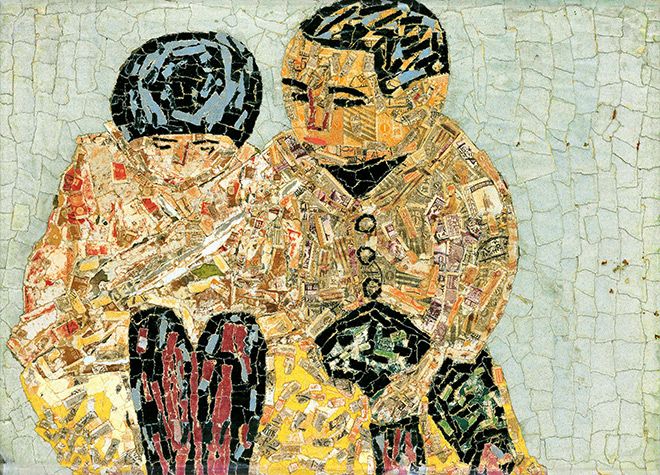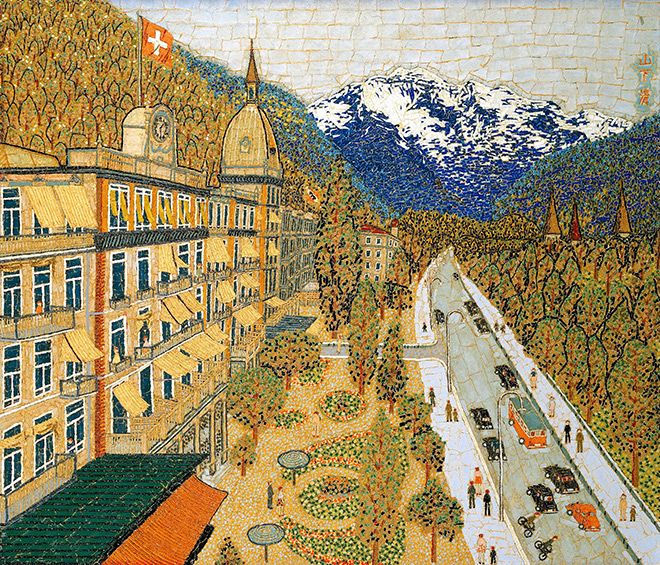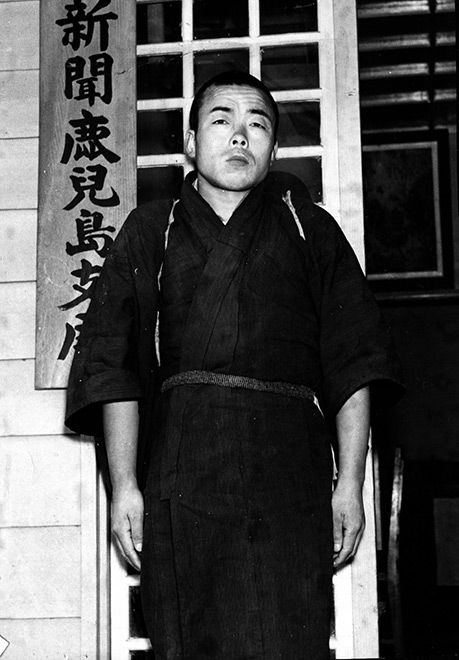Portray genius Kiyoshi Yamashita (1922-1971) is the topic of many TV dramas and movies primarily based on his touring journeys.
In these fictional tales, Kiyoshi is famed for loving onigiri rice balls and venturing out in a tank high and shorts with close-cropped hair.
However what was he actually like in actual life?
A go to to an exhibition titled “a centesimal Anniversary of the Delivery of Yamashita Kiyoshi: A Retrospective” on the Sompo Museum of Artwork in Tokyo’s Nishi-Shinjuku district presents clues.
On show on the exhibit, which can run by means of Sept. 10, are 190 items of artwork together with “hari-e” collages, oil work, ink drawings and watercolors. A backpack and a “yukata” informal kimono that Kiyoshi donned to ramble about are likewise proven.
DIFFICULT EARLY YEARS
Hiroshi Yamashita, 62, Kiyoshi’s nephew who lived with him for practically 11 years till Kiyoshi’s loss of life at age 49, offered private accounts as effectively. Hiroshi is the eldest son of Kiyoshi’s youthful brother, Tatsuzo.
Born within the capital’s conventional Asakusa district, Kiyoshi was suffering from a extreme digestive dysfunction when he was 3.
It was troublesome for Kiyoshi to suit into elementary faculty given his stuttering and developmental issues. As he was bullied, he was transferred to the Yawata Gakuen facility in Chiba Prefecture for kids needing particular care after turning 12.
Kiyoshi shortly mastered the “chigiri-e” paper collage at lessons. He began creating his personal distinctive world of hari-e, exhibiting off his expertise whereas using tiny fragments of coloured paper and their twisted counterparts known as “koyori.”
His early hari-e works made in his teenagers throughout his days at Yawata Gakuen are exhibited on the newest show co-organized by the Sompo Museum of Artwork and The Asahi Shimbun.
Outdated postage stamps, fliers, wrapping materials and different substances had been used for his productions on the time when coloured paper was troublesome to obtain on the house entrance round World Battle II.
Outdated stamps had been utilized to “Pals” and “Chestnuts,” each created in 1938, with the intention of producing a peculiar texture and a stable look alongside delicate contrasts of sunshine and shade skillfully with their patterns.

“Kiyoshi’s portray motifs initially centered on bugs however he steadily started depicting pals, indicating that he expanded his scope of curiosity to mankind, too,” stated Hiroshi.
HITTING THE ROAD FOR ADVENTURE
Turning 18, Kiyoshi left Yawata Gakuen with some belongings in a “furoshiki” wrapping material. This marked the beginning of his famend journeys that continued intermittently till Kiyoshi turned 32.
Drawn afterward in 1955 with a pencil, “Going out from Yawata Gakuen College” illustrates Kiyoshi leaping out of a window with furoshiki. His cool-looking again seems to mirror his dedication.
His departure could be dubbed as “the evening at 18” for Kiyoshi after Yutaka Ozaki’s famed music “15 no Yoru” (The evening at 15), which portrays a teenager’s adolescence.
On his journey, Kiyoshi at instances labored as a live-in at a fish retailer, “soba” noodle restaurant and bento store. He would spend a while at these locations however quickly set out on new journeys to pursue his freedom.
In search of employment, Kiyoshi keep in a single day at stations and walked alongside prepare tracks on his journey to nowhere.
Every time that discovered Kiyoshi with nothing to eat, he would cease at close by houses to ask for onigiri and rice with a bowl in his fingers.
Such a scene is reproduced within the pencil drawing “Getting Free Supper, Fukuroi,” which dates to 1954.
Additionally proven within the heartwarming title is the kindness of individuals within the Showa Period (1926-1989) who offered meals to the needy Kiyoshi, as they had been struggling themselves in dire meals shortages throughout and following the top of the struggle.
The yukata and backpack Kiyoshi wore throughout his travels are additionally among the many showpieces on the exhibition.
He reportedly sometimes relied on yukata in summer season and donned a heat kimono in winter.
The well-worn, brownish backpack is alleged to have accommodated a pair of bowls for rice and soup, chopsticks, a towel, further garments and 5 stones to drive away barking canines to guard himself.
Kiyoshi was in Nagaoka, Niigata Prefecture, in 1949. A fireworks show there was replicated the next yr in “Fireworks, Nagaoka” in a dynamic however delicate style.
It’s a consultant piece of artwork amongst hari-e created by Kiyoshi in his late 20s.
Kiyoshi labored on hari-e after returning to his residence or Yawata Gakuen. He drew on his unimaginable energy of reminiscence to duplicate previous scenes in his thoughts in contrast to the protagonist of his movie and TV dramas creating hari-e and sketches on his journey.
Koyori paper strings had been pasted to depict blooming fireworks. Pyrotechnic works mirrored on the river floor and the crowd-packed venue had been adeptly reproduced within the hari-e in beautiful element.
“Even the fireworks present a yr earlier was full of life illustrated as if he had considered it within the present summer season,” stated Hiroshi.
“The momentary splendor was branded in his thoughts to retrace the scene through a hari-e. All developments in time from the fireworks show’s starting to its finish are captured in a single hari-e.”
Relationship additionally to 1950, “Fishing, Kanamachi” exhibits the high quality designs of individuals’s clothes mirrored on the water floor.
The true enchantment of Kiyoshi’s productions seemingly lies within the daunting stage of detailed handwork.
An exhibit themed on Kiyoshi was held in 1956 at what at the moment is the Daimaru Matsuzakaya Division Retailer in Tokyo, drawing 800,000 guests over its 26-day interval.
With the hari-e “Glover Home” launched the identical yr together with his signature, Kiyoshi began including his mark to works round that point. His elaborately written autograph might signify his satisfaction and confidence as a painter.
EXHIBITION SHOWCASES ARTIST’S LIFE
On the “a centesimal Anniversary of the Delivery of Yamashita Kiyoshi,” artwork followers can take pleasure in Kiyoshi’s distinctive world and the nostalgic atmosphere of the Showa Period by means of a hari-e self-portrait, panorama works primarily based on his travels to Europe, ink drawings and nuanced designs painted on ceramics.
Particularly noticeable are hari-e exhibiting the sights in Germany, Switzerland, France and different areas throughout Europe that appear to be oil work when considered from afar.

Small paper items and koyori had been utilized to comprehend what needs to be labeled as the final word stage of elaboration.
Kiyoshi is likely one of the hottest painters amongst residents in Japan, and his counterfeit works are distributed to the market.
Hiroshi is thus transferring forward of this exercise to cross down the attraction of Kiyoshi’s actual creations to posterity, certifying and maintaining his works whereas managing their copyrights on the identical time.
“My uncle was not extremely esteemed in his earlier days in artwork circles since he had neither graduated from artwork faculty nor acquired existent artwork schooling,” stated Hiroshi.
Hiroshi continued, “Organizing shows at museums was troublesome so his works had been exhibited at occasions in departments shops. Displays can now be held at museums, that means he finally ends up gaining a excessive fame as a painter.”
Hiroshi traced Kiyoshi’s life path.
“My uncle wandered round possible as a result of he wished to come back throughout stunning scenes in a variety of locations,” stated Hiroshi. “He wanted time to consider nothing and valued a versatile way of life so he wouldn’t be restricted by something.
“I would really like fashionable individuals on this busy age to study how my uncle lived his life through the exhibition, too.”
Kiyoshi was known as “Japan’s Van Gogh.” Uttered when he was noticed in Kagoshima Prefecture throughout his journey on the age of 31, the spectacular remark appears to be according to Hiroshi’s recollection.
“I really feel like portray upon discovering good surroundings,” Kiyoshi was quoted as saying in a 1954 Asahi Shimbun article in regards to the discovery of Kiyoshi in Japanese-style clothes and wood sandals with a backpack.

“However I do know nothing about such individuals as Van Gogh or (Henri) Rousseau. I could stay a vagabond for the remainder of my life.”
Encountering the work and phrases of Kiyoshi, individuals lately could possibly calm down as they’re regularly obsessive about unwarranted satisfaction, vainness, social shackles and varied different difficulties.
The “a centesimal Anniversary of the Delivery of Yamashita Kiyoshi” is accessible each day, excluding Mondays, from 10 a.m. by means of 6 p.m. The venue is open for entry till half-hour earlier than the museum’s each day closing.
Admission is 1,400 yen ($10) for adults and 1,100 yen for faculty and college college students. These of elementary, junior excessive and senior highschool age or people with bodily incapacity certificates are exempted from admission.
A reduced advance ticket for adults is out there for 1,300 yen.
Guests don’t have to make reservations beforehand to enter the location on particular dates or throughout sure hours.
For extra particulars, go to the exhibition’s official web site at (https://www.sompo-museum.org/en/exhibitions/2022/yamashitakiyoshi/).
***
Editor’s notice: This text is a part of the Getting old Gracefully Venture, below which The Asahi Shimbun collaborated with Takarajimasha Inc.’s girls’s journal Glow within the hopes of making a society for ladies of their 40s to 50s to take pleasure in rising older.


